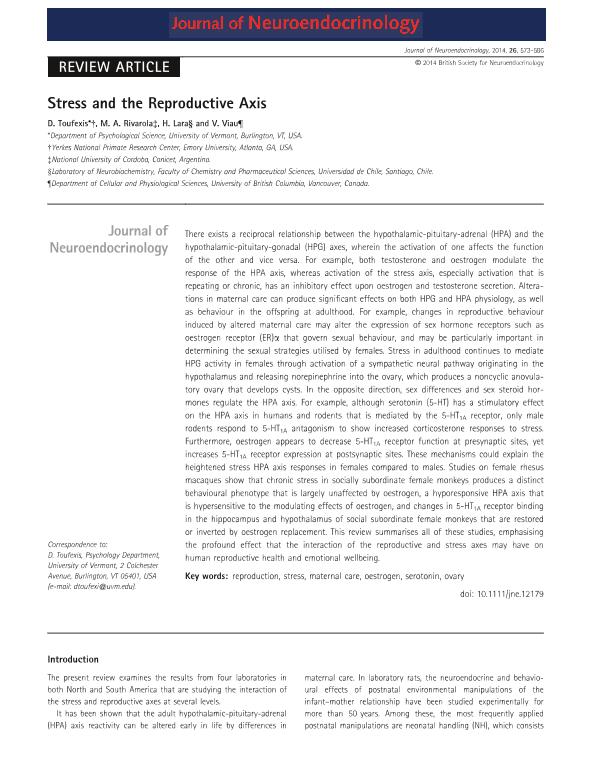Artículo
Stress and the Reproductive Axis
Fecha de publicación:
06/2014
Editorial:
Wiley Blackwell Publishing, Inc
Revista:
Journal of Neuroendocrinology
ISSN:
0953-8194
Idioma:
Inglés
Tipo de recurso:
Artículo publicado
Clasificación temática:
Resumen
There exists a reciprocal relationship between the hypothalamic-pituitary-adrenal (HPA) and the hypothalamic-pituitary-gonadal (HPG) axes, wherein the activation of one affects the function of the other and vice versa. For example, both testosterone and oestrogen modulate the response of the HPA axis, whereas activation of the stress axis, especially activation that is repeating or chronic, has an inhibitory effect upon oestrogen and testosterone secretion. Alterations in maternal care can produce significant effects on both HPG and HPA physiology, as well as behaviour in the offspring at adulthood. For example, changes in reproductive behaviour induced by altered maternal care may alter the expression of sex hormone receptors such as oestrogen receptor (ER)α that govern sexual behaviour, and may be particularly important in determining the sexual strategies utilised by females. Stress in adulthood continues to mediate HPG activity in females through activation of a sympathetic neural pathway originating in the hypothalamus and releasing norepinephrine into the ovary, which produces a noncyclic anovulatory ovary that develops cysts. In the opposite direction, sex differences and sex steroid hormones regulate the HPA axis. For example, although serotonin (5-HT) has a stimulatory effect on the HPA axis in humans and rodents that is mediated by the 5-HT1A receptor, only male rodents respond to 5-HT1A antagonism to show increased corticosterone responses to stress. Furthermore, oestrogen appears to decrease 5-HT1A receptor function at presynaptic sites, yet increases 5-HT1A receptor expression at postsynaptic sites. These mechanisms could explain the heightened stress HPA axis responses in females compared to males. Studies on female rhesus macaques show that chronic stress in socially subordinate female monkeys produces a distinct behavioural phenotype that is largely unaffected by oestrogen, a hyporesponsive HPA axis that is hypersensitive to the modulating effects of oestrogen, and changes in 5-HT1A receptor binding in the hippocampus and hypothalamus of social subordinate female monkeys that are restored or inverted by oestrogen replacement. This review summarises all of these studies, emphasising the profound effect that the interaction of the reproductive and stress axes may have on human reproductive health and emotional wellbeing.
Palabras clave:
Reproduction
,
Stress
,
Maternal Care
,
Estrogen
,
Serotonin
,
Ovary
Archivos asociados
Licencia
Identificadores
Colecciones
Articulos(CCT - CORDOBA)
Articulos de CTRO.CIENTIFICO TECNOL.CONICET - CORDOBA
Articulos de CTRO.CIENTIFICO TECNOL.CONICET - CORDOBA
Citación
Toufexis, Donna; Rivarola, María Angélica; Lara, Hernan; Viau, Victor; Stress and the Reproductive Axis; Wiley Blackwell Publishing, Inc; Journal of Neuroendocrinology; 26; 9; 6-2014; 573-583
Compartir
Altmétricas




